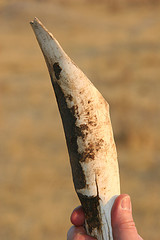With Kenya being the perennial opposition for any trade in ivory, it is no surprise that most opposition is coming from conservation groups in this country. Additionally, Kenya has renewed their push to have a 20 year moratorium on the sale of ivory after this same proposal resulted in pushing the moratorium for only 9 years after the 2008 one-off ivory auction by four southern Africa states. Kenya's media has picked up the story. NTV Kenya has a video on YouTube titled, Wildlife Worries.
The Baraza blog published the content of the proposals that Zambia and Tanzania have put forward and Kenya's opposing proposal. Maina explains on Baraza
On the one hand is the anti-trade range states consisting of Congo, Ghana, Kenya, Liberia, Mali and Sierra Leone. On the other hand, each with it’s own proposal is Zambia and Tanzania, who want to be allowed to sell their ivory stockpiles come the March 13-25 Doha meeting – the 15th CITES Conference of Parties (CoP15). Both sides have sent their proposals to the CITES secretariat and the secretariat has generously posted the proposals on their website.
In a different blog post on Baraza, Paula writes about the UK's resolve to vote against the two proposals:
The UK has said no to ivory sales. Environment Secretary Hilary Benn said last night: “At the CITES meeting in March, the UK will vote against the proposals from Tanzania and Zambia to sell ivory stocks, and we would urge other countries to vote against such a sale.
Paula writes on Ban Ivory – a new blog at WildlifeDirect dedicated to the campaign against ivory – asking “Are elephants worth more than their teeth“. She asks: “Are elephants just a source of a valuable commodity, ivory? Or do elephants deserve special treatment?”
Paula points out that inspite of all the support that Africans can expect from outside, the battle for the elephant will have to start with Africans. She says:
At the end of the day the protest against the trade in ivory will have to be led by Africans if the rest of the world is to take any notice which makes Kenya’s campaign so powerful. But as long as the Chinese and other Asians markets continue to provide markets for ivory trinkets and refuse to implement domestic enforcement, a renewed ban on trade in ivory will fail and we will continue to lose elephants.
A group known as the Kenya Elephant Forum is leading the Kenyan civil society in the protest against ivory trade resumption and have produced fact sheets on the issue. Harvey Croze, blogging on the Amboseli Trust for Elephants pages says
ATE is against the trade. We have been working with like-minded NGOs and individuals under the aegis of the Kenya Elephant Forum (KEF) to provide strategic information to a body of sympathetic African elephant range states called the African Elephant Coalition (AEC).
In this blog post, Harvey has included links to the KEF Fact Sheets that you may want to read in order to understand the ivory problem and the likely implication of the Tanzania/Zambia proposals.








2 comments
Africa’s elephants faced annihilation after 3 decades of rampant poaching during the seventies and eighties, it was through CITES 1989 that saved elephant population from extint. Kenya recent called the neighboring elephant range state to discuss about how to conserve cross border elephant population, this is a good move since most of the African elephant range state experience cross border, the biggest park in Tanzania Seleo Naasa extend all the way to Mozambique after getting elephant discharge population from Mikumi, Lake Manyara where Kenya elephant goes;
A DNA study 2008 shows that elephant in Tanzania have relatives in Kenya, Tsavo, Amboseli and Mara region. The worst of all in the proposal is the use of hides and live animals, this is going to cause social discruption as elephants lives in the family and after math of this is elephant will begin dying over stress which is very serious.